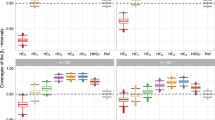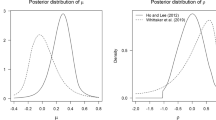Abstract
This paper proposes a model to further explore the effects of the quality information and variation of the underlying effects on the summary effect measure in meta-analysis. A shape parameter is used in this model to quantify the asymmetry of the effect sizes of studies that are included. Estimation of the proposed model parameters is carried out by the Bayesian MCMC method. Performances of the resultant estimates are examined in the simulations and empirical case with data obtained from a total of 22 meta-analyses taken from three different designs. A conclusion would be drawn that it is advisable to take the proposed model, when quality information becomes available, in particular with a situation where the underlying effects approximately follow a normal distribution. If, however, the quality information is absent, the skew-normal distribution for random effect model should be adopted.
Similar content being viewed by others
References
Sutton A J and Higgins J P T, Recent development in meta-analysis, Statistics in Medicine, 2008, 27(5): 625–650.
Hozo S P, Djulbegovic B, and Hozo I, Estimating the mean and variance from the median, range, and the size of a sample, BMC Medical Research Methodology, 2005, 5(1): 13.
Wan X, Wang W, Liu J, et al., Estimating the sample mean and standard deviation from the sample size, median, range and/or interquartile range, BMC Medical Research Methodology, 2014, 14(1): 135–135.
Luo D, Wan X, Liu J, et al., Optimally estimating the sample mean from the sample size, median, mid-range, and/or mid-quartile range, Statistical Methods in Medical Research, 2018, 27(6): 1785–1805.
DerSimonian R and Laird N, Meta-analysis in clinical trials, Controlled Clinical Trials, 1986, 7(3): 177–188.
Senn S, Trying to be precise about vagueness, Statistics in Medicine, 2007, 26(7): 1417–1430.
Verhagen A P, de Vet H C W, de Bie R A, et al., The art of quality assessment of RCTs included in systematic reviews, Journal of Clinical Epidemiology, 2001, 54(7): 651–654.
Berard A and Bravo G, Combining studies using effect sizes and quality scores: Application to bone loss in postmenopausal women, Journal of Clinical Epidemiology, 1998, 51(10): 801–807.
Tritchler D L, Modelling study quality in meta-analysis, Statistics in Medicine, 1999, 18(16): 2135–2145.
Fleiss J L and Gross A J, Meta-analysis in epidemiology, with special reference to studies of the association between exposure to environmental tobacco smoke and lung cancer: A critique, Journal of Clinical Epidemiology, 1991, 44(2): 127–139.
Shadish W R and Haddock C K, Combining estimates of effect size, Eds. by Cooper H, Hedges L V, and Valentine J C, The handbook of research synthesis and meta-analysis (p.257 C277). Russell Sage Foundation, 2009.
Doi S A R and Thalib L, A quality-effects model for meta-analysis, Epidemiology, 2008, 19(1): 94–100.
Doi S A R, Barendregt J J, and Mozurkewich E L, Meta-analysis of heterogeneous clinical trials: An empirical example, Contemporary Clinical Trials, 2011, 32(2): 288–298.
Doi S A R, Barendregt J J, Khan S, et al., Advances in the meta-analysis of heterogeneous clinical trials II: The quality effects model, Contemporary Clinical Trials, 2015, 45: 123–129.
Doi S A R, Barendregt J J, Khan S, et al., Advances in the meta-analysis of heterogeneous clinical trials I: The inverse variance heterogeneity model, Contemporary Clinical Trials, 2015, 45: 130–138.
Greenland S and O’Rourke K, On the bias produced by quality scores in meta-analysis, and a hierarchical view of proposed solutions, Biostatistics, 2001, 2(4): 463–471.
Ahn S and Becker B J, Incorporating quality scores in meta-analysis, Journal of Educational and Behavioral Statistics, 2011, 36(5): 555–585.
Lee K J and Thompson S G, Flexible parametric models for random-effects distributions, Statistics in Medicine, 2008, 27(3): 418–434.
Arellano-Valle R B, Bolfarine H, and Lachos V H, Skew-normal linear mixed models, Journal of Data Science, 2005, 3(4): 415–438.
Lin T I and Lee J C, Estimation and prediction in linear mixed models with skew-normal random effects for longitudinal data, Statistics in Medicine, 2008, 27(9): 1490–1507.
Wu M, Zhao J, Wang T, et al., The ANOVA-type inference in linear mixed model with skew-normal error, Journal of Systems Science and Complexity, 2017, 30(3): 710–720.
Macgillivray H L, Skewness and asymmetry: Measures and orderings, The Annals of Statistics, 1986, 14(3): 994–1011.
Wen F and Yang X, Skewness of return distribution and coefficient of risk premium, Journal of Systems Science and Complexity, 2009, 22(3): 360–371.
Bailey K R, Inter-study differences: How should they influence the interpretation and analysis of results? Statistics in Medicine, 1987, 6(3): 351–358.
Turner R M, Spiegelhalter D J, Smith G C S, et al., Bias modelling in evidence synthesis, Journal of the Royal Statistical Society: Series A (Statistics in Society), 2009, 172(1): 21–47.
Thompson S, Ekelund U, Jebb S, et al., A proposed method of bias adjustment for meta-analyses of published observational studies, International Journal of Epidemiology, 2010, 40(3): 765–777.
Spiegelhalter D J and Best N G, Bayesian approaches to multiple sources of evidence and uncertainty in complex cost effectiveness modelling, Statistics in Medicine, 2003, 22: 3687–3709.
Doi S A R, Evidence synthesis for medical decision making and the appropriate use of quality scores, Clinical Medicine & Research, 2014, 12(1–2): 40–46.
Kulinskaya E and Olkin I, An overdispersion model in meta-analysis, Statistical Modelling, 2014, 14(1): 49–76.
Pewsey A, Problems of inference for Azzalini’s skewnormal distribution, Journal of Applied Statistics, 2000, 27(7): 859–870.
Bayes C L and Branco E, Bayesian inference for the skewness parameter of the scalar skew-normal distribution, Brazilian Journal of Probability and Statistics, 2007, 21(2): 141–163.
Gelman A, Prior distributions for variance parameters in hierarchical models (comment on article by Browne and Draper), Bayesian Analysis, 2006, 1(3): 515–534.
Doi S A R, Woodhouse N J, Thalib L, et al., Ablation of the thyroid remnant and I-131 dose in differentiated thyroid cancer: A meta-analysis revisited, Clinical Medicine and Research, 2007, 5(2): 87–90.
Higgins P T and Green S, Cochrane Handbook for Systematic Reviews of Interventions, John Wiley and Sons, New Jersey, 2011.
Arellano-Valle R B, Gmez, Hctor W, and Quintana F A, A new class of skew-normal distributions, Communications in Statistics — Theory and Methods, 2004, 33(7): 1465–1480.
Azzalini A, A class of distributions which includes the normal ones, Scandinavian Journal of Statistics, 1985, 12(2): 171–178.
Henze N, A probabilistic representation of the skew-normal distribution, Scandinavian Journal of Statistics, 1986, 13(4): 271–275.
Gupta R C and Brown N, Reliability studies of the skew-normal distribution and its application to a strength-stress model, Communications in Statistics — Theory and Methods, 2001, 30(11): 2427–2445.
Author information
Authors and Affiliations
Corresponding author
Additional information
This research was supported by the Natural Science Research Foundation of China (Key Projects) under Grant No. 11831008, the Natural Science Research Foundation of China under Grant No. 11971235.
Rights and permissions
About this article
Cite this article
Fu, J., Lin, J. Incorporating Variation and Quality of the Underlying Effects in Meta-Analysis. J Syst Sci Complex 35, 2381–2397 (2022). https://doi.org/10.1007/s11424-022-1429-5
Received:
Revised:
Published:
Issue Date:
DOI: https://doi.org/10.1007/s11424-022-1429-5




